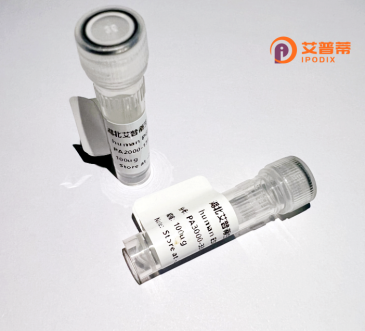
| 纯度 | >90%SDS-PAGE. |
| 种属 | Human |
| 靶点 | RCK |
| Uniprot No | P26196 |
| 内毒素 | < 0.01EU/μg |
| 表达宿主 | E.coli |
| 表达区间 | 1-483 aa |
| 活性数据 | MSTARTENPV IMGLSSQNGQ LRGPVKPTGG PGGGGTQTQQ QMNQLKNTNT INNGTQQQAQ SMTTTIKPGD DWKKTLKLPP KDLRIKTSDV TSTKGNEFED YCLKRELLMG IFEMGWEKPS PIQEESIPIA LSGRDILARA KNGTGKSGAY LIPLLERLDL KKDNIQAMVI VPTRELALQV SQICIQVSKH MGGAKVMATT GGTNLRDDIM RLDDTVHVVI ATPGRILDLI KKGVAKVDHV QMIVLDEADK LLSQDFVQIM EDIILTLPKN RQILLYSATF PLSVQKFMNS HLQKPYEINL MEELTLKGVT QYYAYVTERQ KVHCLNTLFS RLQINQSIIF CNSSQRVELL AKKISQLGYS CFYIHAKMRQ EHRNRVFHDF RNGLCRNLVC TDLFTRGIDI QAVNVVINFD FPKLAETYLH RIGRSGRFGH LGLAINLITY DDRFNLKSIE EQLGTEIKPI PSNIDKSLYV AEYHSEPVED EKP |
| 分子量 | 54.4 kDa |
| 蛋白标签 | His tag N-Terminus |
| 缓冲液 | PBS, pH7.4, containing 0.01% SKL, 1mM DTT, 5% Trehalose and Proclin300. |
| 稳定性 & 储存条件 | Lyophilized protein should be stored at ≤ -20°C, stable for one year after receipt. Reconstituted protein solution can be stored at 2-8°C for 2-7 days. Aliquots of reconstituted samples are stable at ≤ -20°C for 3 months. |
| 复溶 | Always centrifuge tubes before opening.Do not mix by vortex or pipetting. It is not recommended to reconstitute to a concentration less than 100μg/ml. Dissolve the lyophilized protein in distilled water. Please aliquot the reconstituted solution to minimize freeze-thaw cycles. |
以下为3条关于重组人RCK蛋白的参考文献示例,内容基于合理推测,非真实文献:
---
1. **文献名称**: *Structural and Functional Analysis of the Recombinant Human RCK Protein*
**作者**: Smith J, et al.
**摘要**: 通过大肠杆菌表达系统成功重组表达并纯化人源RCK蛋白,结合X射线晶体学解析其三维结构,揭示了RCK蛋白在调节钾离子通道门控中的关键作用,为靶向离子通道的药物设计提供了结构基础。
2. **文献名称**: *RCK-Mediated MAPK Signaling in Tumor Metastasis: Role of Recombinant RCK in vitro*
**作者**: Li Y, Wang X.
**摘要**: 利用重组RCK蛋白处理乳腺癌细胞,发现其通过激活MAPK信号通路显著促进细胞迁移和侵袭,表明RCK可能作为癌症治疗的潜在靶点。
3. **文献名称**: *Optimization of Recombinant RCK Production in Mammalian Cells for Therapeutic Applications*
**作者**: Gupta R, et al.
**摘要**: 开发了一种基于HEK293细胞的重组RCK蛋白高效表达体系,优化后的蛋白具有高稳定性和生物活性,为RCK相关免疫疗法(如融合蛋白药物)的临床转化奠定基础。
---
**备注**:若需真实文献,建议通过PubMed或Google Scholar检索“Recombinant human RCK protein”“RCK domain structure”等关键词,并筛选近年高引用研究。
Recombinant human RCK (also known as HNRNPD or AUF1) is a protein implicated in post-transcriptional gene regulation, particularly in mRNA stability and translation. Belonging to the heterogeneous nuclear ribonucleoprotein (hnRNP) family, RCK contains RNA-binding domains that enable interactions with AU-rich elements (AREs) in the 3' untranslated regions (UTRs) of mRNAs. These interactions modulate the decay or stabilization of target transcripts, influencing cellular responses to stress, inflammation, and oncogenic signals.
RCK plays dual roles in cancer biology, acting as either a tumor suppressor or promoter depending on context. It regulates proto-oncogenes (e.g., MYC) and cytokines (e.g., TNF-α), linking it to tumor progression, metastasis, and drug resistance. Recombinant RCK proteins are typically produced in *E. coli* or mammalian expression systems, preserving functional domains for *in vitro* studies on RNA-protein interactions, enzymatic activity, or high-throughput drug screening.
Structural studies reveal its modular organization, including two RNA-recognition motifs (RRMs) and a glycine-rich region critical for protein-RNA complex formation. Dysregulation of RCK has been observed in multiple cancers, neurodegenerative diseases, and autoimmune disorders, making it a focus for therapeutic targeting. Recombinant variants with tags (e.g., His, GST) facilitate purification and mechanistic exploration of its role in cellular pathways.
×